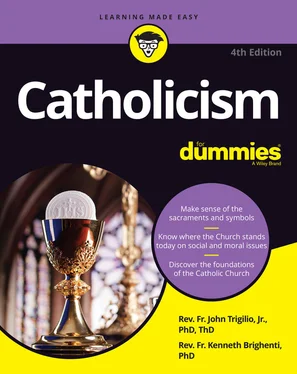Because the Catholic Church has a billion-plus members, the pope depends on many helpers to govern the vast institution. The ranking system goes like this: The pope’s at the helm, followed by cardinals, archbishops/bishops, vicars general, monsignors, and priests. The rest of the Church is made up of deacons, monks, nuns, brothers, sisters, and laypersons. (The latter — lay men and lay women — make up 99.9 percent of the Church.)
Although the primary responsibility of the College of Cardinals is to elect a pope (see the earlier section “ How the pope gets his job”), cardinals have many other responsibilities as well. The Roman Curia is the whole group of administrators (Cardinal Prefects) who head up their departments (congregations, tribunals, and so on), working together as the right hand of the pope. The pope governs through the Roman Curia, something like cabinet members who assist the president or department ministers who assist the prime minister. For example, a Cardinal Secretary of State represents the Holy See to foreign governments, because Vatican City is the world’s smallest independent country. And you can find a different cardinal heading up each congregation, such as the Congregation for
Doctrine of the Faith
Bishops
Catholic Education
Causes of the Saints
Clergy
Divine Worship and Discipline of the Sacraments
Evangelization of Peoples
Institutes of Consecrated Life and Societies of Apostolic Life
Oriental Churches
A different cardinal also heads up each of several commissions and councils, as well as three high courts of the Catholic Church: the Apostolic Penitentiary, the Apostolic Signatura, and the Roman Rota, all of which deal with canon law (see Chapter 11) and its application and interpretation.
Cardinals who don’t work in the Curia run an archdiocese, mostly functioning as an archbishop would — ordaining, confirming, and doing the day-to-day business of being chief shepherd of the archdiocese. These cardinals are also often the metropolitans, which means that they supervise the province of two to several dioceses, usually all in the same state or region. (We define archdiocese and diocese in the next section.) A metropolitan doesn’t have immediate authority over neighboring bishops or their dioceses even though they’re within the cardinal archbishop’s province as metropolitan .
A metropolitan does report to Rome, however, if one of the bishops in his province is derelict in his duties, commits scandal or crime, and so on. Often, the apostolic nuncio, the papal ambassador to that country, consults with the cardinal when vacancies appear in his province, as in the case of a bishop dying or retiring. For example, the Cardinal Archbishop of Philadelphia is the Metropolitan for Pennsylvania, which incorporates the eight dioceses of Philadelphia, Pittsburgh, Erie, Harrisburg, Scranton, Allentown, Greensburg, and Altoona-Johnstown.
The pope personally selects the men who become cardinals. The ceremony where new cardinals are created is called a consistory, and it usually occurs every few years to replace those who have retired (or will soon retire), as well as those who have died since the last consistory. This way, the goal of 120 cardinal electors is more likely achieved should the pope die, in which case a conclave is called to elect a new pope. Since the pontificate of St. John Paul II, a concerted effort has been made to have a diverse spectrum of cardinals from all continents and from both Latin and Eastern Catholic Rites.
Besides being the head of the Catholic Church, the pope is also the bishop of Rome. The pope isn’t more a bishop than any other bishop, but his authority covers more territory. The pope has supreme, full, immediate, and universal jurisdiction all over the world, whereas a local bishop, who may also be an archbishop or a cardinal, possesses jurisdiction only in his diocese, which is the typical geographical designation in Catholic governance — an administrative territory.
Dioceses and archdioceses: The areas that bishops govern
Each individual bishop retains his own authority, which comes from episcopal ordination and consecration. Episcopal refers to anything that has to do with a bishop or bishops, and episcopal ordination and consecration is the sacrament by which a priest becomes a bishop. It’s the third and fullest level of the Sacrament of Holy Orders. (The first level is the ordination of a deacon, and the second is the ordination of a priest. Deacons, priests, and bishops are all considered clergy. )
The local bishop runs the diocese. He’s not an ambassador of the pope but governs the local diocese as an authentic successor of the apostles, just as the pope governs the universal Church as the successor of St. Peter.
The pope appoints the bishops, and they must make a visit to the Holy Father every five years and give a report on their particular diocese. The rest of the time, the bishop goes around the diocese confirming adults and teenagers, ordaining men to the diaconate (the office of deacon), and ordaining men to the priesthood once a year. Only bishops have the authority to administer the Sacrament of Holy Orders whereby men are ordained deacons, priests, or bishops. Bishops make pastoral visits to the parishes and chair numerous meetings with their staff. (See Chapter 8for more on the Sacrament of Confirmation, and see Chapter 9for more on the Sacrament of Holy Orders.) A bishop is like a pastor of an extra-large parish. (See the later section “ The parish priest” for details about pastors.)
The local diocese is a collection of local parishes, just like a state is a collection of counties and cities. Many dioceses are comprised of several state counties, and in a few places, the entire state makes up one diocese.
 In general, you can think of a local parish as being like a town or city, and the local pastor as being like the mayor. The diocese is like a state or province, and the bishop is like the governor. (The pope is like the prime minister, governing the entire nation, except that he governs the universal Church all over the world.)
In general, you can think of a local parish as being like a town or city, and the local pastor as being like the mayor. The diocese is like a state or province, and the bishop is like the governor. (The pope is like the prime minister, governing the entire nation, except that he governs the universal Church all over the world.)
An archbishop runs a really large diocese, known as an archdiocese. For example, an archbishop is given authority in each of the following archdioceses: Newark, San Francisco, Denver, Hartford, Miami, St. Louis, and Omaha. Sometimes, though, the archbishop is also a cardinal, which is often the case in Philadelphia, New York City, Boston, Chicago, Baltimore, Los Angeles, Detroit, and Washington, D.C.
The bishops within an entire country or nation get together at least once a year in a gathering known as an episcopal conference. The American bishops belong to the United States Conference of Catholic Bishops (USCCB); the Canadian Bishops belong to the Canadian Conference of Catholic Bishops (CCCB); in Australia, it’s the Australian Catholic Bishops Conference (ACBC); and in Great Britain, it’s the Catholic Bishops’ Conference of England and Wales (CBCEW).
Cathedrals: The place where bishops hang out
The cathedral is to the local diocese what the Vatican is to the universal Church. The cathedral is the official church of the diocese where the bishop’s chair resides, and his chair ( cathedra in Latin) is a symbol of his authority as a successor to the apostles.
 Ironically, St. Peter’s Basilica in the Vatican, where the pope celebrates most of his Masses, isn’t technically the pope’s cathedral church. The cathedral for the diocese of Rome is actually St. John Lateran, where the popes originally lived before moving to the Vatican in the 14th century.
Ironically, St. Peter’s Basilica in the Vatican, where the pope celebrates most of his Masses, isn’t technically the pope’s cathedral church. The cathedral for the diocese of Rome is actually St. John Lateran, where the popes originally lived before moving to the Vatican in the 14th century.
Читать дальше

 In general, you can think of a local parish as being like a town or city, and the local pastor as being like the mayor. The diocese is like a state or province, and the bishop is like the governor. (The pope is like the prime minister, governing the entire nation, except that he governs the universal Church all over the world.)
In general, you can think of a local parish as being like a town or city, and the local pastor as being like the mayor. The diocese is like a state or province, and the bishop is like the governor. (The pope is like the prime minister, governing the entire nation, except that he governs the universal Church all over the world.) Ironically, St. Peter’s Basilica in the Vatican, where the pope celebrates most of his Masses, isn’t technically the pope’s cathedral church. The cathedral for the diocese of Rome is actually St. John Lateran, where the popes originally lived before moving to the Vatican in the 14th century.
Ironically, St. Peter’s Basilica in the Vatican, where the pope celebrates most of his Masses, isn’t technically the pope’s cathedral church. The cathedral for the diocese of Rome is actually St. John Lateran, where the popes originally lived before moving to the Vatican in the 14th century.










